║┌Č┤╔ńŪ° reports forgotten plan for 80-storey Foster & Partners-designed tower to replace NatWest following IRA bomb which killed one and damaged 155 buildings in the heart of the City
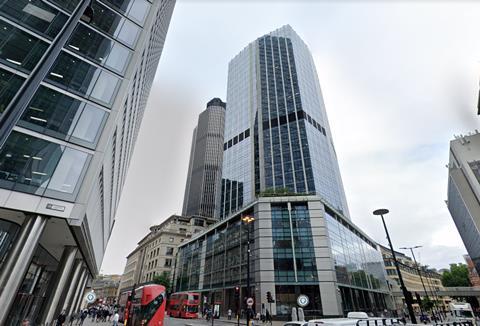
When walking among the City of LondonŌĆÖs shiny new office towers, it is easy to forget how much of the Square Mile felt like a warzone in the 1990s. The bombing of Bishopsgate on 24 April 1993 was one of nearly 20 IRA attacks on London during the decade, coming just over a year after the bombing of the Baltic Exchange on St Mary Axe, just around the corner.
The Bishopsgate bomb killed one person, News of the World photographer Edward Henty, and gutted several buildings, including 99 Bishopsgate and the NatWest Tower.
The three news stories below cover the immediate reaction to the attack and the potential cost of repair. Also printed was an interview with chief City planner Peter Rees, who called for the NatWest Tower to be demolished and replaced with an 80-storey tower designed by Foster + Partners as ŌĆ£a symbol of defiance to the IRAŌĆØ. It never came to pass, but the tower would have been by far the tallest in the UK and one of the tallest in Europe had it been built.
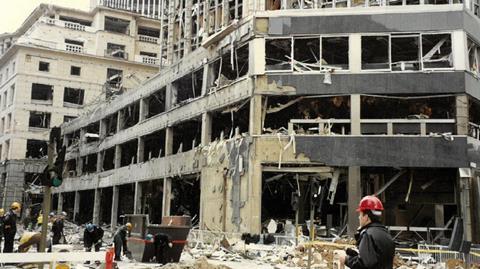
News story, 30 April 1993
Emergency repairs delayed by red tape, say contractors
Contractors employed to shore up bomb-damaged buildings in Bishopsgate claim they lost vital hours over the weekend because of excessive bureaucracy by police and City of London officials.
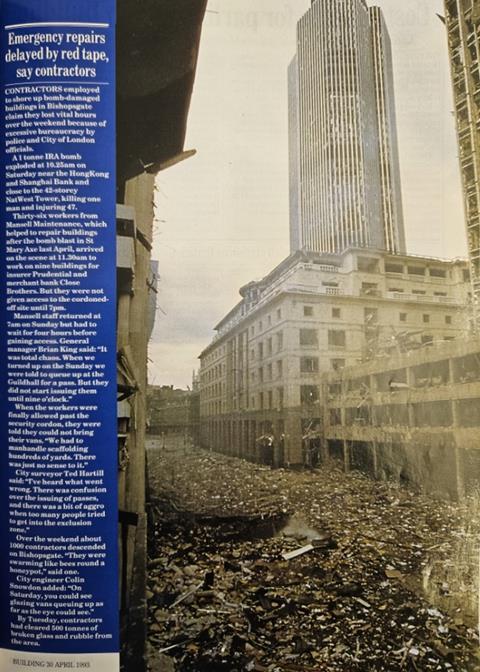
A 1 tonne IRA bomb exploded at 10.25am on Saturday near the HongKong and Shanghai Bank and close to the 42-storey NatWest Tower, killing one man and injuring 47.
Thirty-six workers from Mansell Maintenance, which helped to repair buildings after the bomb blast in St Mary Axe last April, arrived on the scene at 11.30am to work on nine buildings for insurer Prudential and merchant bank Close Brothers. But they were not given access to the cordoned- off site until 7pm.
Mansell staff returned at 7am on Sunday but had to wait for four hours before gaining access. General manager Brian King said: ŌĆ£It was total chaos. When we turned up on the Sunday we were told to queue up at the Guildhall for a pass. But they did not start issuing them until nine oŌĆÖclock.ŌĆØ
When the workers were finally allowed past the security cordon, they were told they could not bring their vans. ŌĆ£We had to manhandle scaffolding hundreds of yards. There was just no sense to it.ŌĆØ City surveyor Ted Hartill said: ŌĆ£IŌĆÖve heard what went wrong. There was confusion over the issuing of passes, and there was a bit of aggro when too many people tried to get into the exclusion zone.ŌĆØ
Over the weekend about 1000 contractors descended on Bishopsgate. ŌĆ£They were swarming like bees round a honeypot,ŌĆØ said one.
City engineer Colin Snowdon added: ŌĆ£On Saturday, you could see glazing vans queuing up as far as the eye could see.ŌĆØ By Tuesday, contractors had cleared 500 tonnes of broken glass and rubble from the area.
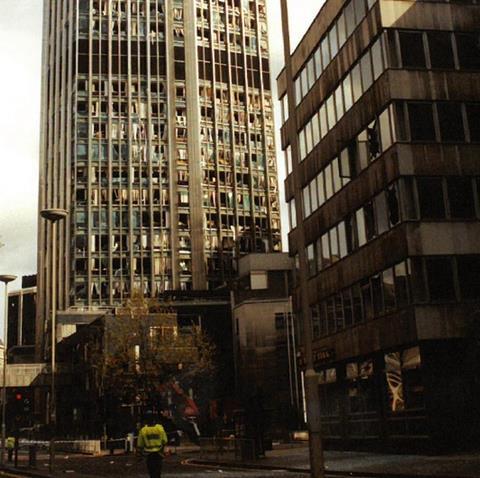
News story, 30 April 1993
City planner calls for total redevelopment
Pull down Natwest Tower and build new skyscraper, says Rees. Adrian Barrick reports.
Corporation of London chief planner Peter Rees this week called for the demolition of the NatWest tower and other buildings damaged in last SaturdayŌĆÖs IRA bomb attack so that they can be replaced by a single 80-storey skyscraper.
Speaking to ║┌Č┤╔ńŪ° on Monday, Rees said the devastation presented an ŌĆ£ideal opportunityŌĆØ to rid the City of London of some of its least-loved buildings, and to erect ŌĆ£a symbol of defiance to the IRAŌĆØ.
City engineer Colin Snowdon said this week that at least two buildings in Bishopsgate - St Ethelburga Church and Kansallis House next door, which took the full impact of the explosion - would have to be demolished. Consultants fear that at least three others may have to be pulled down (details below).
But Rees said that any redevelopment of Bishopsgate should also include pulling down the 600ft NatWest Tower, designed by Richard Seifert and regarded as one of the great 1970s office towers.
The replacement tower should be twice as tall, making it ŌĆ£one of the tallest buildings in EuropeŌĆØ. It should be built on a site just north of the current NatWest Tower and designed by Sir Norman Foster, he said.
David Edmonds, NatWestŌĆÖs general manager of group property, said ReesŌĆÖ proposal was ŌĆ£a very interesting suggestion which we had not thought of. But present thinking is that we have a superb building which has served us well.ŌĆØ
Meanwhile, NatWest is about to submit a planning application for an ┬Ż80m scheme to redevelop Apex House, close to the Bank of England. It is also working on plans with Trafalgar House and SOM to turn part of its 1960s office tower at DraperŌĆÖs Gardens into a luxury hotel.
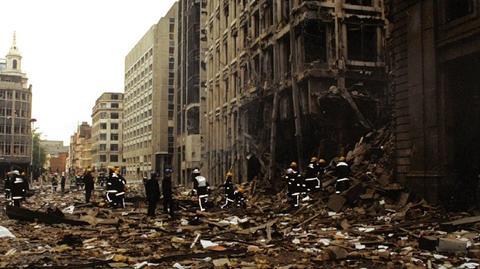
News story, 30 April 1993
Consultants warn that costs of rebuilding could far outstrip early estimates
The cost of rebuilding the City of London in the wake of last SaturdayŌĆÖs bomb attack is likely to exceed ┬Ż500m and could involve the demolition of at least five buildings, according to leading consultants this week.
The assessment far exceeds calculations by senior Corporation of London officials who put the likely level of insurance claims at ┬Ż350m, similar to the cost of rebuilding following the IRA bomb attack in the City last April which severely damaged the Baltic Exchange and the Commercial Union tower. Both buildings were hit again in SaturdayŌĆÖs blast.
But Francis Ives, senior partner of quantity surveyor Cyril Sweett & Partners, which acted as a loss assessor for the Baltic Exchange last year, said: ŌĆ£There is greater damage from this bomb than the last one. I would imagine the cost will be ┬Ż500-700m.ŌĆØ
The corporation also said on Tuesday that only two buildings are likely to need demolition - the 1000-year-old St Ethelburga Church, which was reduced to a pile of rubble, and neighbouring Kansallis House, which took the full impact of the blast.
City engineer Colin Snowdon said a further 155 buildings were damaged by the blast, 25 of them severely. Consultants who inspected other buildings in Bishopsgate early this week predicted that five buildings may have to be pulled down.
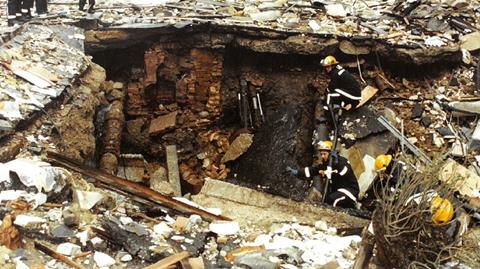
Ives warned that the podium of offices around the 26-storey HongKong and Shanghai Bank tower at 99 Bishopsgate ŌĆ£looks as if they will need to be demolishedŌĆØ and the 1975 tower ŌĆ£may not be worth savingŌĆØ. A bank spokeswoman said the tower was still being assessed by the original engineer Bylander Waddle.
Ives said the National Bank of Abu Dhabi at 90 Bishopsgate, for which Sweett is acting as loss assessor, is likely to be stripped back to its steel frame. ŌĆ£The cladding is shot and the interiors were blown right through.ŌĆØ
Also at risk of demolition is a row of Victorian shops at 20-26 Wormwood Street, where roofs were blown in and frontages ripped out.
Another consultant said there was concern about possible structural damage to 55 Bishopsgate, completed by Bovis just two years ago. Robin Booth, a partner of the architect Fitzroy Robinson, which had 12 buildings hit, said steel-framed structures like 55 Bishopsgate would need careful examination. ŌĆ£The effect of the bomb on the fixings of the masonry facade, which is hung on the steel frame, would need to be tested. There could be hairline cracks around the fixings, and a frost next winter could force the stonework off.
Booth also said there was a danger that buildings would have to be demolished if the bomb blast had twisted their steel frames.
Fitzroy Robinson was also this week examining a concrete-framed building at 38 Bishopsgate. The building was also danged in the 1992 blast, and contractor Trollope & Colls is understood to have been close to finishing repairs when the IRA struck again.
The 42-storey NatWest Tower lost up to a third of its 12,000 windows and had internal doors and ceilings ripped out. The buildingŌĆÖs original engineer Pell Frischmann was assessing damage Tuesday, but NatWestŌĆÖs general manager of group property David Edmonds said: ŌĆ£We have no concern about structural damage until a full survey has been done and that will take three or four weeks.ŌĆØ
Sweett also warned other owners that it could take several months for structural damage to appear ŌĆ£At the Baltic Exchange, panels of marble dropped off ceilings and walls weeks later. This was because the steel frame which had been pushed back, recovered to original position, springing the marble off,ŌĆØ Ives said.
More from the archives:
>> NelsonŌĆÖs Column runs out of money, 1843-44
>> The clearance of LondonŌĆÖs worst slum, 1843-46
>> The construction of the Palace of Westminster, 1847
>> Benjamin DisraeliŌĆÖs proposal to hang architects, 1847
>> The Crystal PalaceŌĆÖs leaking roof, 1851
>> Cleaning up the Great Stink, 1858
>> Setbacks on the worldŌĆÖs first underground railway, 1860
>> The opening of Clifton Suspension Bridge, 1864
>> Replacing Old Smithfield Market, 1864-68
>> Alternative designs for Manchester Town Hall, 1868
>> The construction of the Forth Bridge, 1873-90
>> The demolition of Northumberland House, 1874
>> Dodging falling bricks at the Natural History Museum construction site, 1876
>> An alternative proposal for Tower Bridge, 1878
>> The Tay Bridge disaster, 1879
>> ║┌Č┤╔ńŪ° in Bombay, 1879 - 1892
>> Cologne CathedralŌĆÖs topping out ceremony, 1880
>> BritainŌĆÖs dim view of the Eiffel Tower, 1886-89
>> First proposals for the Glasgow Subway, 1887
>> The construction of Westminster Cathedral, 1895-1902
>> WestminsterŌĆÖs unbuilt gothic skyscraper 1904
>> The great San Francisco earthquake, 1906
>> The construction of New YorkŌĆÖs Woolworth ║┌Č┤╔ńŪ°, 1911-13
>> The First World War breaks out, 1914
>> The Great War drags on, 1915-16
>> LondonŌĆÖs first air raids, 1918
>> The Chrysler ║┌Č┤╔ńŪ° and the Empire State ║┌Č┤╔ńŪ°, 1930
>> The Daily Express ║┌Č┤╔ńŪ°, 1932
>> Outbreak of the Second World War, 1939
>> Britain celebrates victory in Europe, 1945
>> How buildings were affected by the atomic bombs dropped on Japan, 1946
>> Rebuilding the House of Commons chamber, 1945
>> Planning the postwar New Towns, 1945-46
>> The Festival of Britain, 1951
>> The worldŌĆÖs first nuclear power station, 1956-57
>> ║┌Č┤╔ńŪ° covers the 1964 election
>> Liverpool Metropolitan Cathedral, 1967
>> The new London Bridge, 1973
>> Queen Elizabeth II opens the Barbican Centre, 1982
>> Trouble at the LloydŌĆÖs building, 1986
>> How Broadgate was built at record speed, 1986
>> Planning Canary Wharf, 1982-88
>> The collapse of Olympia & York, 1992























No comments yet